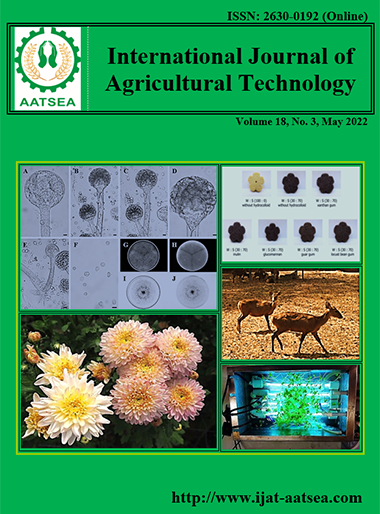Egg hatchability of junglefowls (Gallus gallus Linnaeus) by natural method, artificial insemination and incubator
Main Article Content
Abstract
The first experiment resulted that junglefowl naturally bred had significantly higher egg numbers than artificial insemination (p < 0.05), with an average of 34.29 ± 16.87 and 20.00 ± 5.41, respectively. Regarding the number of fertile eggs, it was found that the natural method was significantly lower than artificial insemination (p < 0.05) with an average of 12.94 ± 1.36 and 34.50 ± 12.04 eggs, respectively. The second experiment showed that hatching by natural method, which the hens incubated the eggs in the nest, the hatching rate was 78.57 ± 13.47%. Moreover, the eggs hatched in the incubator had the hatching rate of 67.43 ± 8.15%, of which, both methods had not statistically differed (p > 0.05). However, hatching in an incubator was better than orther methods as it shortened the incubation time of the laying hens. Consequently, it resulted in hens to be able to lay more eggs than hens that hatched naturally.
Article Details

This work is licensed under a Creative Commons Attribution-NonCommercial-NoDerivatives 4.0 International License.
References
Anwar, N., Ali, S., Rais, M. and Mahmood, T. (2016). Breeding ecology of red junglefowl (Gallus gallus) in Deva Vatala National Park, Azad Jammu and Kashmir, Pakistan. Journal of Applied Agriculture and Biotechnology, 1:59-65.
Boonsanong, S. (2002). Breeding, laying eggs, hatching and rearing of Siamese fireback Wildlife Conservation Office, National Park, Wildlife and Plant Conservation Department, Thailand, p.15.
Boonsanong, S. (2004) Study on effect of eggshell color on hatchability of red junglefowl (Gallus gallus spadiceus). Wildlife Conservation Office, National Park, Wildlife and Plant Conservation Department, Thailand, p.7.
Boonsanong, S. and Prasertsan, S. (2004). Egg character identification of some pheasant. Wildlife Conservation Office, National Park, Wildlife and Plant Conservation Deparment, Thailand, p.12.
Boonsanong, S. (2009). Pheasant breeding guide. Wildlife Conservation Office, National Park Wildlife and Plant Conservation Department, Thailand, 102 p.
Bump, G. and Bohl, W. H. (1961). Red JungleFowl and Kalij Pheasants. US Fish and Wildlife Service, Washington, D.C. Special Scientific Report. Wildlife No. 62, p.41.
Dorji1, N., Duangjinda, M. and Y. Phasuk. (2012). Genetic characterization of Bhutanese native chickens based on an analysis of Red Junglefowl (Gallus gallus gallus and Gallus gallus spadecieus), domestic Southeast Asian and commercial chicken lines (Gallus gallus domesticus). Genetics and Molecular Biology, 35:603-609.
Kerje, S., Carlborg, O., Jacobsson, L., Schutz, K., Hartmann, C., Jensen, P. and Andersson, L. (2003). The twofold difference in adult size between the red junglefowl and White Leghorn chickens is largely explained by a limited number of QTLs. International Society for Animal Genetics. Animal Genetics, 34:264-274.
McBride, G., Parer, I. P. and Foenander, F. (1969). The social organization and behavior of the feral domestic fowls. Animal behavior monographs, 2:127-181.
Meijer, T. and Siemers, I. (1993). Incubation development and asynchronous hatching in jungle fowl. Behaviour, 127:309-322.
Nolte, T., Jansen, S., Weigend, S., Moerlein, D., Halle, I., Simianer, H. and Sharif, A.R. (2021). Genotypic and dietary effects on egg quality of local chicken breeds and their crosses fed with faba beans. Animals, 11:1-17.
Nishida, T., Tanaka, K., Fugio, Y. and Shctabe, T. (1975). The study on the interrelationship between Malasia jungle fowl and native poultry and morphological investigations on native livestock in Malaysia. University of Tokyo, Japan.
Romanov, M. N. and Weigendt, S. (2001). Analysis of genetic relationships between various population of domestic and junglefowl using microsatellite marker. Poultry Science, 80:1057-1063.
Saeki, Y. and Inoue, Y. (1979). Body growth, egg production, broodiness, age at first egg and egg size in red junglefowls, and an attempt at their genetic analyses by the reciprocal crossing with white leghorns. Japanese Poultry Science, 16:121-126.
Zakaria, A. H. (1999). Ovarian follicular growth in laying hens in relation to sequence length and egg position in various sequence length. Arch. Geflu¨gelkd, 63:264-269.


